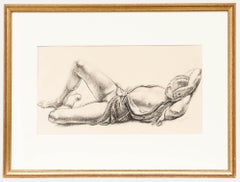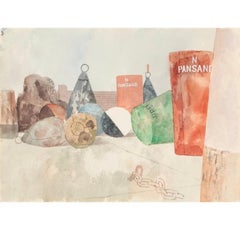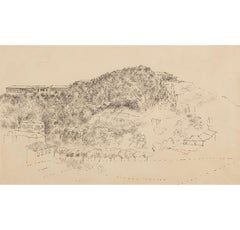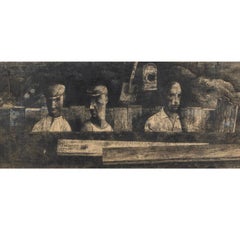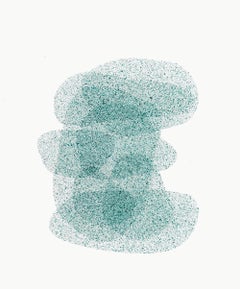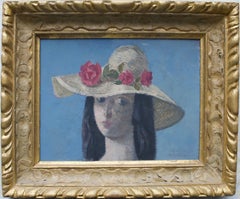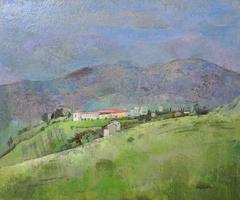Reginald Brill Art
to
5
5
1
Reginald Brill (1902-1974) - 1931 Pen and Ink Drawing, Reclining Nude
By Reginald Brill
Located in Corsham, GB
A striking ink study by the artist Reginald Brill (1902-1974) depicting a reclining nude lady. The artist expertly uses hatching to create this wonderfully tonal piece and captures t...
Category
Early 20th Century Reginald Brill Art
Materials
Pen
Italian Scene, Pen and Ink with Wash Painting by Reginald Brill, 1950s circa
By Reginald Brill
Located in Kingsclere, GB
Italian Scene, Pen and Ink with Wash Painting by Reginald Brill, 1950s circa
Additional information:
Medium: Pen and ink with wash
33 x 48.3 cm
13 x 19 in
Reginald " Reggie" Brill was a versastile 20th century artist and teacher.
Brill was born in London in 1902 and spent his early childhood there and in Yorkshire. By the time of the First World War, at the age of 13, he was living in lodgings in London, working in a City office and attending St Martins School of Art in the evenings. Considering his lack of education, winning a scholarship to The Slade (now part of University College London) in 1921 where he studied under Henry Tonks for three years, was a huge achievement.
On leaving The Slade he found patronage in Lincolnshire, but by the time of the General Strike (1926) he had returned to London and was working on Lansbury's Labour Weekly. He married Rosalie, also an artist, and in 1927 won the Prix de Rome in Decorative Painting. Following two years at The British School in Rome, Brill went to teach at Blackheath School of Art. During 1930 he spent three months painting in Egypt and it was there that he met Col. T G Gayer-Anderson, one of the twin brothers who were to bequeath The Little Hall in Lavenham as a hostel for art students. It was there that Brill retired to act as warden, thus continuing his nurturing of art students until his death in 1972.
Brill took up his appointment at The School of Art, Kingston upon Thames in January 1934. It was situated in the Technical Institute (Kingston Hall Road) and Brill found it bohemian and disorganised. He proceeded to inject enthusiasm, order and discipline. Within 5 years of his appointment a purpose-built School of Art was opened in Knights Park. It remained open throughout the war and by 1945 there was a waiting list for places. Under the skilled and totally dedicated direction of Brill, Kingston School of Art became established with national reputation for excellence. In 1961 Sir Charles Wheeler opened the new building at Knights Park. Costing £100,000, this more than doubled the size of the Art School.
Brill, was a well-known figure in Kingston. His eloquence made him popular as a guest speaker and his promotion of Art and Design stretched well beyond the doors of Knights Park. Apart from establishing two of the main buildings which makeup what is now known as the Faculty of Design, one of the most visible local contributions he made was the setting up of a topographical collection of paintings depicting Kingston, which has since become known as The Brill Collection at Kingston Museum. Brill gained huge respect and admiration from the hundreds of pupils who studied at Kingston during his 30-year leadership.
He published two books, Modern Painting 1946 and Art as a Career 1962, both bearing a strong educational angle. He regularly exhibited along with leading artists of his era at The Royal Academy, both his paintings and his acutely observed drawings. All the while he was a prolific artist, although reading his diaries, intensely self-critical. His perfectionism, acute powers of observation and relentless research can be seen in his drawings, which via the media and methods he explored throughout his life reflect mid 20th century British Art at its most typical. His major series of work, known as 'The Martyrdom of Man', was carried on in parallel to his career as a teacher. These paintings reflect his care for fellow man and depict people at work, e.g., The Operation, The Jury, Linemen, Waiting Room and Rest, which recently sold at Sotheby’s and was specially restored for The Brill Retrospective. His smaller works also play with the theme of everyday events and communication amongst people, such as The Bull Ring and Market Place paintings.
Brill's name is associated particularly with human figure compositions, but he also worked on landscapes, portraits and details of plants, animals, interiors etc. As one would expect he moved from one media to another, and his unusual hand painted and cut paper mosaics...
Category
20th Century Reginald Brill Art
Materials
Pen
Buoys No.3, Watercolour Painting by Reginald Brill
By Reginald Brill
Located in Kingsclere, GB
Buoys No.3, Watercolour Painting by Reginald Brill
Additional information:
Medium: Watercolour
24 x 34 cm
9 1/2 x 13 3/8 in
Titled verso
This is part of a group of keenly observed ...
Category
20th Century Reginald Brill Art
Materials
Watercolor
Italian Landscape, Pen Painting by Reginald Brill, 1950 circa
By Reginald Brill
Located in Kingsclere, GB
Italian Landscape, Pen Painting by Reginald Brill, 1950 circa
Additional information:
Medium: Ink
20 x 34 cm
7 7/8 x 13 3/8 in
Reginald " Reggie" Brill was a versastile 20th century artist and teacher.
Brill was born in London in 1902 and spent his early childhood there and in Yorkshire. By the time of the First World War, at the age of 13, he was living in lodgings in London, working in a City office and attending St Martins School of Art in the evenings. Considering his lack of education, winning a scholarship to The Slade (now part of University College London) in 1921 where he studied under Henry Tonks for three years, was a huge achievement.
On leaving The Slade he found patronage in Lincolnshire, but by the time of the General Strike (1926) he had returned to London and was working on Lansbury's Labour Weekly. He married Rosalie, also an artist, and in 1927 won the Prix de Rome in Decorative Painting. Following two years at The British School in Rome, Brill went to teach at Blackheath School of Art. During 1930 he spent three months painting in Egypt and it was there that he met Col. T G Gayer-Anderson, one of the twin brothers who were to bequeath The Little Hall in Lavenham as a hostel for art students. It was there that Brill retired to act as warden, thus continuing his nurturing of art students until his death in 1972.
Brill took up his appointment at The School of Art, Kingston upon Thames in January 1934. It was situated in the Technical Institute (Kingston Hall Road) and Brill found it bohemian and disorganised. He proceeded to inject enthusiasm, order and discipline. Within 5 years of his appointment a purpose-built School of Art was opened in Knights Park. It remained open throughout the war and by 1945 there was a waiting list for places. Under the skilled and totally dedicated direction of Brill, Kingston School of Art became established with national reputation for excellence. In 1961 Sir Charles Wheeler opened the new building at Knights Park. Costing £100,000, this more than doubled the size of the Art School.
Brill, was a well-known figure in Kingston. His eloquence made him popular as a guest speaker and his promotion of Art and Design stretched well beyond the doors of Knights Park. Apart from establishing two of the main buildings which makeup what is now known as the Faculty of Design, one of the most visible local contributions he made was the setting up of a topographical collection of paintings depicting Kingston, which has since become known as The Brill Collection at Kingston Museum. Brill gained huge respect and admiration from the hundreds of pupils who studied at Kingston during his 30-year leadership.
He published two books, Modern Painting 1946 and Art as a Career 1962, both bearing a strong educational angle. He regularly exhibited along with leading artists of his era at The Royal Academy, both his paintings and his acutely observed drawings. All the while he was a prolific artist, although reading his diaries, intensely self-critical. His perfectionism, acute powers of observation and relentless research can be seen in his drawings, which via the media and methods he explored throughout his life reflect mid 20th century British Art at its most typical. His major series of work, known as 'The Martyrdom of Man', was carried on in parallel to his career as a teacher. These paintings reflect his care for fellow man and depict people at work, e.g., The Operation, The Jury, Linemen, Waiting Room and Rest, which recently sold at Sotheby’s and was specially restored for The Brill Retrospective. His smaller works also play with the theme of everyday events and communication amongst people, such as The Bull Ring and Market Place paintings.
Brill's name is associated particularly with human figure compositions, but he also worked on landscapes, portraits and details of plants, animals, interiors etc. As one would expect he moved from one media to another, and his unusual hand painted and cut paper mosaics...
Category
20th Century Reginald Brill Art
Materials
Pen
Study for Men in the Trench, Pen, Ink & Watercolour on Paper Painting 1950 circa
By Reginald Brill
Located in Kingsclere, GB
Study for Men in the Trench, Pen, Ink & Watercolour on Paper Painting 1950 circa
Additional information:
Medium: Pen, ink and watercolour on paper
11 3/4 x 26 in
29.8 x 68.5 cm
Reginald " Reggie" Brill was a versastile 20th century artist and teacher.
Brill was born in London in 1902 and spent his early childhood there and in Yorkshire. By the time of the First World War, at the age of 13, he was living in lodgings in London, working in a City office and attending St Martins School of Art in the evenings. Considering his lack of education, winning a scholarship to The Slade (now part of University College London) in 1921 where he studied under Henry Tonks for three years, was a huge achievement.
On leaving The Slade he found patronage in Lincolnshire, but by the time of the General Strike (1926) he had returned to London and was working on Lansbury's Labour Weekly. He married Rosalie, also an artist, and in 1927 won the Prix de Rome in Decorative Painting. Following two years at The British School in Rome, Brill went to teach at Blackheath School of Art. During 1930 he spent three months painting in Egypt and it was there that he met Col. T G Gayer-Anderson, one of the twin brothers who were to bequeath The Little Hall in Lavenham as a hostel for art students. It was there that Brill retired to act as warden, thus continuing his nurturing of art students until his death in 1972.
Brill took up his appointment at The School of Art, Kingston upon Thames in January 1934. It was situated in the Technical Institute (Kingston Hall Road) and Brill found it bohemian and disorganised. He proceeded to inject enthusiasm, order and discipline. Within 5 years of his appointment a purpose-built School of Art was opened in Knights Park. It remained open throughout the war and by 1945 there was a waiting list for places. Under the skilled and totally dedicated direction of Brill, Kingston School of Art became established with national reputation for excellence. In 1961 Sir Charles Wheeler opened the new building at Knights Park. Costing £100,000, this more than doubled the size of the Art School.
Brill, was a well-known figure in Kingston. His eloquence made him popular as a guest speaker and his promotion of Art and Design stretched well beyond the doors of Knights Park. Apart from establishing two of the main buildings which makeup what is now known as the Faculty of Design, one of the most visible local contributions he made was the setting up of a topographical collection of paintings depicting Kingston, which has since become known as The Brill Collection at Kingston Museum. Brill gained huge respect and admiration from the hundreds of pupils who studied at Kingston during his 30-year leadership.
He published two books, Modern Painting 1946 and Art as a Career 1962, both bearing a strong educational angle. He regularly exhibited along with leading artists of his era at The Royal Academy, both his paintings and his acutely observed drawings. All the while he was a prolific artist, although reading his diaries, intensely self-critical. His perfectionism, acute powers of observation and relentless research can be seen in his drawings, which via the media and methods he explored throughout his life reflect mid 20th century British Art at its most typical. His major series of work, known as 'The Martyrdom of Man', was carried on in parallel to his career as a teacher. These paintings reflect his care for fellow man and depict people at work, e.g., The Operation, The Jury, Linemen, Waiting Room and Rest, which recently sold at Sotheby’s and was specially restored for The Brill Retrospective. His smaller works also play with the theme of everyday events and communication amongst people, such as The Bull Ring and Market Place paintings.
Brill's name is associated particularly with human figure compositions, but he also worked on landscapes, portraits and details of plants, animals, interiors etc. As one would expect he moved from one media to another, and his unusual hand painted and cut paper mosaics...
Category
20th Century Reginald Brill Art
Materials
Pen
Related Items
Contemporary Watercolor Painting, 'Design for Light', c. 2000 by David Ruth
By David Ruth
Located in Oakland, CA
This is a contemporary abstract watercolor painting by artist David Ruth. This series of paintings often feature bright colors and vibrant layouts that draw the viewer in. They are c...
Category
Early 2000s Abstract Expressionist Reginald Brill Art
Materials
Paper, Watercolor
Abstract Watercolor N.8 by Dmitry Samygin
By Dmitry Samygin
Located in Paris, FR
Abstract Watercolor N.8 by Dmitry Samygin
Minimalist and geometric paintings.
Technique: Watercolor
Color: Teal blue
Size: H. 35.5 x 27.5 x 0.1 cm
Dmitry Samygin is a Furniture a...
Category
21st Century and Contemporary Abstract Geometric Reginald Brill Art
Materials
Watercolor
Les femmes
Located in La Baule-Escoublac, FR
Bergstein grew up in France between Paris and Saint-Rémy-de-Provence. At the age of 18, he flew to Barcelona, Spain where he joined an industrial design school. Back in Paris, he com...
Category
2010s Contemporary Reginald Brill Art
Materials
Linen, Ink, Pen
Vintage Pen & Ink Sketch - Close Couple
By Jean-Charles Lauthe
Located in Houston, TX
Vintage pen & ink line drawing of a couple posing for the artist on a sofa by French artist and film director Jean-Charles Lauthe, circa 1930.
Original ...
Category
1930s Reginald Brill Art
Materials
Ink, Paper, Pen
$200 Sale Price
20% Off
H 20 in W 0.1 in D 16 in
Open door - line drawing figure
By Mila Akopova
Located in Fort Lee, NJ
Interior design paintings. The artwork was done with white pen on black watercolor paper 360g. The works are 11,5 by 16,5 inches in size, framed (black) with a styrene face on a mat board in black and white with sizes 16 by 20 in.
Mila Akopova is New York artist.
She graduated from Moscow State University with a degree in History and Theory of Art.
Her Artwork got 3rd place at the 2020 American Art Awards, juried by 25 best galleries and museums in America, with artist from 63 countries, in category: minimalism. Also, several works took part in exhibitions of the All-Russian Decorative Art Museum and in the Cube Moscow exhibition space . It was published as the catalog: “The game of tic tac toe, or creating a collection in one year”. Several works by Mila Akopva were created specifically for the collaboration with Vintage Dream...
Category
2010s Abstract Reginald Brill Art
Materials
Paper, Felt Pen
Les Captives by Paul Delvaux - Nudes, Work on paper, Ink
By Paul Delvaux
Located in London, GB
*PLEASE NOTE UK BUYERS WILL ONLY PAY 5% VAT ON THIS PURCHASE.
Les Captives by Paul Delvaux (1897-1994)
Pen, Indian ink and wash on paper
35 x 43.5 cm (13 ³/₄ x 17 ¹/₈ inches)
Signed and dated lower right, P. Delvaux 1955
Inscribed on the reverse
Provenance: Christie's London, 2010
Private collection, London, acquired from the above
Artist biography:
Belgian artist Paul Delvaux was born in Liège in eastern Belgium. Despite Delvaux’s desire to become an artist, his lawyer father encouraged him to train as an architect at the prestigious Académie Royale des Beaux-Arts in Brussels.
Thanks to private art tuition undertaken alongside his architectural studies, in 1925 Delvaux gained his first solo exhibition in Brussels. Heavily influenced by contemporary Expressionism and Surrealism, Delvaux was soon drawn to the ‘metaphysical’ paintings of Italian artist Giorgio de Chirico. On a chance visit to a museum of medical curiosities...
Category
1950s Surrealist Reginald Brill Art
Materials
Paper, India Ink, Pen
$32,019
H 13.78 in W 17.13 in
Les trois muses
Located in La Baule-Escoublac, FR
Bergstein grew up in France between Paris and Saint-Rémy-de-Provence. At the age of 18, he flew to Barcelona, Spain where he joined an industrial design school. Back in Paris, he com...
Category
2010s Contemporary Reginald Brill Art
Materials
Linen, Ink, Pen
Nude in Negligee /// Contemporary Female Lesbian LGBT Figurative Women Artists
By Emilia Castaneda
Located in Saint Augustine, FL
Artist: Emilia Castañeda (Spanish, 1943-)
Title: "Nude in Negligee"
*Signed by Castaneda in pencil lower right
Circa: 1980
Medium: Original Pen & Ink and Watercolor Drawing on wove p...
Category
1980s Contemporary Reginald Brill Art
Materials
Ink, Watercolor, Pen
Surrealist
Located in Houston, TX
French pen and ink surrealist drawing with female and avian elements, 1993. Signed lower right.
Original artwork on paper displayed on a white mat with a gold border. Mat fits a s...
Category
1990s Reginald Brill Art
Materials
Ink, Pen
From Renaissance Venice to Barocco Naples, a drawing by Francesco La Marra
Located in PARIS, FR
This vigorous drawing presents a brilliant synthesis between the Venetian tradition of Titian, of which it is a distant echo, and the Neapolitan Baroque of Solimena, which strongly i...
Category
Mid-18th Century Old Masters Reginald Brill Art
Materials
Paper, Ink, Felt Pen
$10,770
H 25.25 in W 20.38 in
Marcel GROMAIRE (1892-1971), female nude
By Marcel Gromaire
Located in Paris, FR
Marcel Gromaire (1892 – 1971) was a French painter. He painted many works on social subjects and is often associated with Social Realism, but Gromaire can be said to have created an ...
Category
1950s French School Reginald Brill Art
Materials
Paper, Ink, Pen
French Pen & Ink - Artist's Muse
By Jean-Baptiste Grancher
Located in Houston, TX
Black and white pen & ink drawing of a nude female model posing for an artist by French artist Jean Baptiste Grancher, circa 1950.
Original artwork on paper displayed on a white mat...
Category
1950s Reginald Brill Art
Materials
Ink, Paper, Pen
Previously Available Items
Reginald Brill, The Sun hat, Modern British oil portrait of a young lady
By Reginald Brill
Located in Harkstead, GB
Reginald Brill (1902-1974)
The Sun hat,
Signed,
Oil on board,
9 x 12 inches.
14 x 17 inches with frame
Exhibited: The Phoenix Gallery, Lavenham, Suffolk, 1975.
Provenance: Privat...
Category
Mid-20th Century Modern Reginald Brill Art
Materials
Oil, Board
Italian hilltop town
By Reginald Brill
Located in Sutton Poyntz, Dorset
This original oil painting by Reginald Brill, dating from around 1950s, is presented and supplied in its original frame that has been redressed and freshened with colouring to suit t...
Category
Mid-20th Century Modern Reginald Brill Art
Materials
Canvas, Oil
Reginald Brill art for sale on 1stDibs.
Find a wide variety of authentic Reginald Brill art available for sale on 1stDibs. Customers who are interested in this artist might also find the work of Philip Gilbert Hamerton, John Wilkes, and Jonathan Chritchley.
